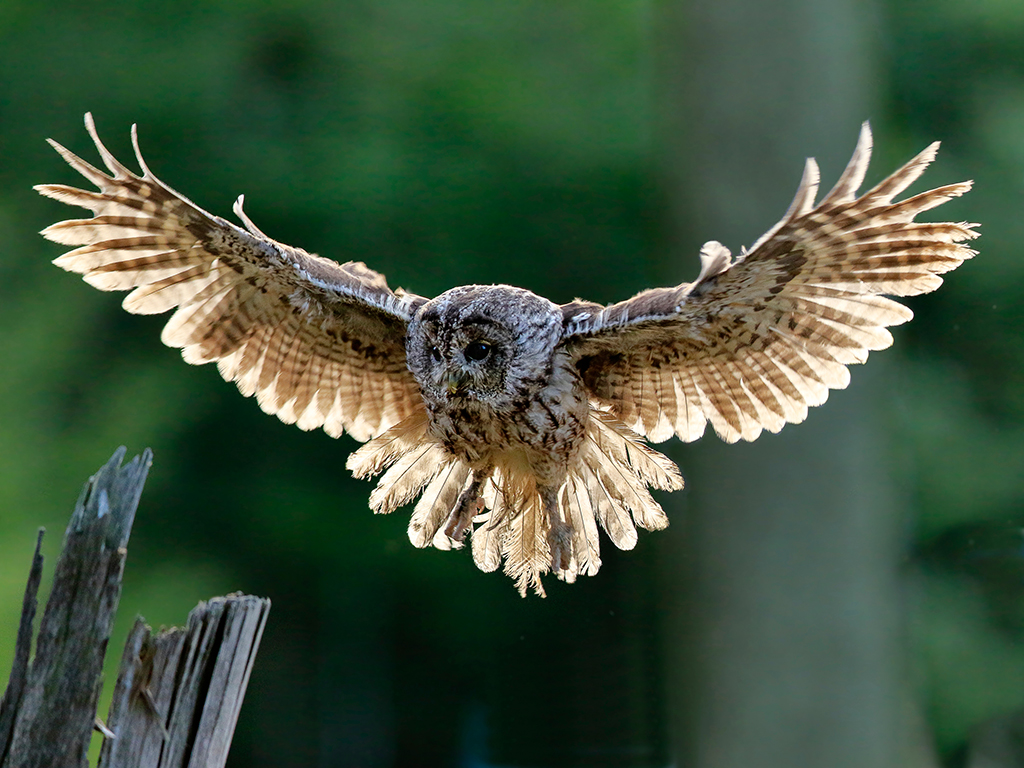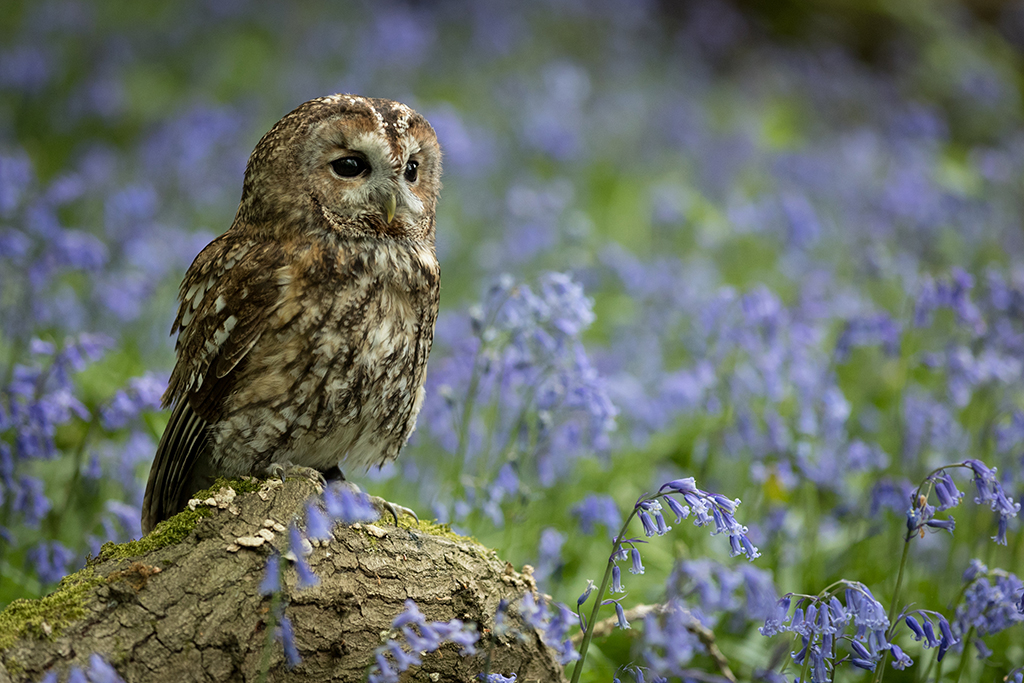In rescuing and nursing injured birds, our wildlife writer has discovered that owls have much to teach us about how to adapt to changing habitats and overcome natural and man-made hazards.
My passion for our most widespread and common owl, the tawny, began before I started school.
I would creep to the corner of the old stable yard behind our Highlands house and hide in the shadows to watch a large brown owl roosting in the crumbling sandstone buildings. It captivated me. This, coupled with the extraordinary pellets it regurgitated – furry little parcels which contained the immaculate white bones, skulls and even the minute yellowed teeth of its primary prey, the field vole – further added to the intrigue.
There are four native British owl species: the barn owl, the long-eared owl, the short-eared owl and the tawny owl. Vagrants are also recorded in Scotland most years.
In 1989 I was asked to look after a male snowy owl that had been found, oily and bedraggled, on a tanker crossing the Atlantic from Canada. It had to be carefully washed and kept in quarantine until eventually an SSPCA inspector and I were flown to Shetland with the bird as a VIP passenger.
With the assistance of the RSPB, it was released on Fetlar in the hope that it might stay to breed with the last two lone females. Sadly, like many males, this owl had wanderlust and left the island soon after. No snowy owls have bred in Scotland since.
Owls are intriguing creatures. Their large forward-facing eyes and upright stance mean they’re anthropomorphised more than most birds. Their soft, loose plumage, with fringed feathers to allow silent flight, hides a surprisingly small body and skull.
It makes them appear enchanting and gentle, and conceals huge, efficient, cat-like talons. Owls are killers and have been seen as creatures of evil and harbingers of doom, shrouded in mystery and legend. The fact that many species of owl, particularly the barn and tawny, frequent graveyards only adds to their ghoulish reputation.

Yet they do so merely because it is a perfect habitat for small mammalian prey, and a church’s ancient masonry provides peaceful roost and nest sites. An owl’s extraordinary range of orchestrations – hoots, caterwauls, shrieks, hisses and churrs – has sent many a nervous person fleeing from a moonlit necropolis.
Perhaps the biggest myth about owls is that they are wise. Having spent a great deal of time studying them, I have found that compared to corvids – crows, ravens, rooks and magpies, for example – owls can actually be a bit dim. Over the years many injured owls have been brought to me. They are frequently hit by cars, as verges are a vole-rich habitat.
They are often orphaned when trees are felled, or are blown from the nest when young. And there are countless man-made hazards that cause mayhem, such as water troughs where they go to bathe and then cannot extricate themselves.
The brilliant yellow-eyed short-eared owl, largely diurnal and frequenting moorland and winter estuaries, is seldom brought in as a casualty since it tends to stay away from man. Similarly, its close relative, the orange-eyed long-eared owl, is shy and secretive and is usually found nesting in remote stands of native trees. Highly nervous, both make poor patients, and in any case their injuries tend to be badly broken wings or legs, from which there is no going back.
In comparison, barn owls are easy to deal with, breed well in captivity and can have a surprising number of young in a year, thanks to repeat clutches. During the 1980s and 1990s there was a trend for keeping them in captivity and many were released at the end of each season.
In Scotland the barn owl is at the northern limit of its range and will struggle to survive in hard winters. Many young barn owls we nursed were aviary-bred birds that should never have been released because they were so ill-equipped to hunt that they were on the brink of starvation.
The owl that I nurse most often is the ubiquitous tawny. There are around 6,000 breeding pairs in Scotland, although numbers fluctuate depending on the weather and the availability of their main prey, the short-tailed field vole.
Though once a bird of deciduous woodland, the tawny has adapted brilliantly to living alongside man and is now found in a surprising range of habitats, even co-existing with us in the middle of the busiest towns. This inevitably has a cost.
I have become used to odd phone calls. The most memorable was one asking me to look after an owl that had narrowly missed being ‘canned’.
It had flown into a pea canning plant in Montrose and went through every stage of the process, including grading, washing, shelling and blanching, before being spewed out, narrowly avoiding the grand finale of the cannery. It was in a very sorry state, regurgitating hard little peas for quite some time as it battled for its life. It was eventually returned to the wild.

I am frequently called to tawnies in trouble; they get stuck in wood-burning stoves, fly into open windows and have even been found trying to nest in one concerned woman’s sideboard. Tawny owls are not ornate nest-builders and tend to choose hollow trees, disused buildings and craggy ledges, as well as all manner of bizarre spots.
I observed one pair rearing their young in the leather upholstery of a rusty dumped car. Another pair nest in the chimney of the bothy adjacent to our house. This causes problems as the owlets sometimes fall on to the gravel beneath and get lost in the shrubs. I have even considered placing a trampoline under the nest to break their fall.
Young owls are vulnerable. They spend about a month in the nest, then leave the safe haven dressed in heavy grey down that may become lethally sodden in our frequent summer deluges. Many of these ‘branchers’ are picked up when they should be left alone and end up being hand-reared, lowering their already slim chances of making it through their first winter.
I have had to hand-rear dozens, and have sometimes put owlets into the nests of other families, though this is hazardous as the tawny can attack with outstretched talons. One trio were particularly memorable.
In a desperate bid to teach the birds that live mice were fodder, I lured mice into a large bin using a plank baited with cheese. The owlets sat on the edge of the bin, their heads swivelling quizzically, but it was many days before one finally dropped into the bin and made a kill. They became far too tame and flew in through the open bedroom window in the middle of the night, begging me to feed them.
Following the release of any hand-reared owls, I always leave food out; it is doubtful they would survive without it. While it is the tawny that has the best-known vocalisations (the typical ‘tu whit tu woo’ and the female’s ‘kewick’ call), this owl is largely nocturnal and seldom seen. They have two colour phases, grey and rufous, perfect camouflage, which means they may be roosting very close at hand without being seen.
However, the furious scolding of blackbirds often gives the game away. Despite this fuss, an owl will sit tight unless disturbed by a human and then, in silent flight, it will mysteriously slip away into the depths of a wood.
TAGS

